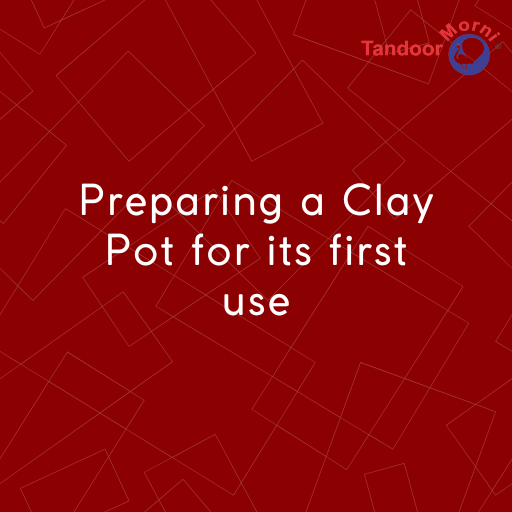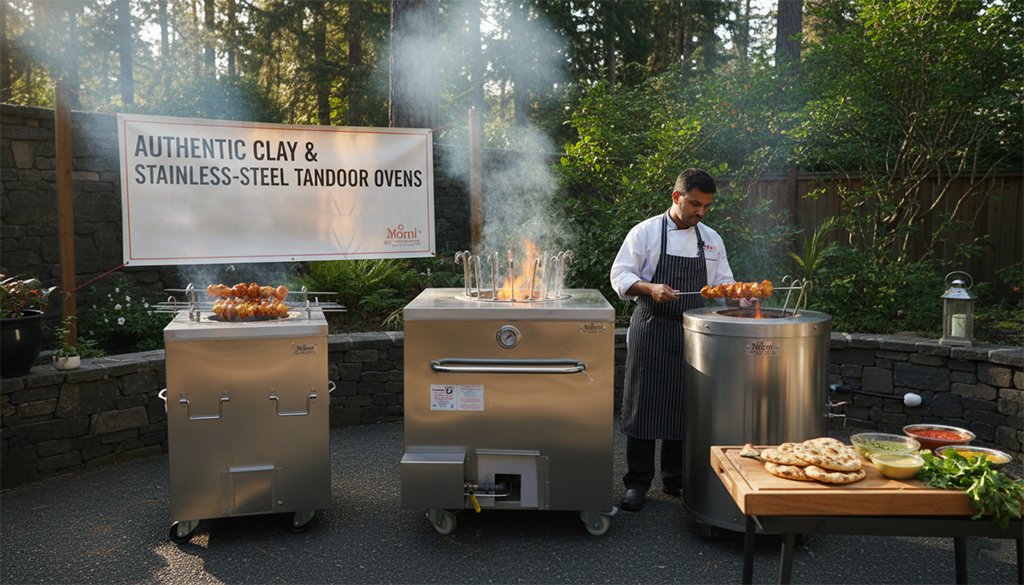
Seasoning/Curing Tandoor Clay Pot: A Simple Guide
The tandoor clay pot is an essential tool for making traditional tandoori dishes like naan, kebabs, and roasted meats. It has been used for centuries in places like the eastern Mediterranean, India, and Central Asia. If you want your Tandoor Clay Pot to last and perform well, you need to prepare it properly before you start cooking. This process, known as seasoning or curing, helps the clay pot adjust to the heat and prevents cracks or other damage. It also makes sure your food doesn’t stick to the pot. Follow these steps to learn how to properly cure and maintain your tandoor clay pot for the best cooking results.
Why Should You Cure a Tandoor Clay Pot?
Before diving into the “how,” it’s important to understand the “why.” Seasoning a tandoor clay pot is necessary for several reasons:
- Prevents Cracking: Clay is a natural material that can crack when exposed to high heat too quickly. Curing helps the clay adjust to the heat gradually, which prevents cracks.
- Stops Food from Sticking: A properly seasoned pot forms a protective layer inside, preventing the dough or meats from sticking to the walls when cooking.
- Improves Cooking Results: Seasoning helps you get that perfect char on naan and kebabs, making them taste just like they do at authentic tandoori restaurants.
- Extends the Life of the Pot: When you take care of your tandoor clay pot, it can last for many years. Curing is the first step to make sure your investment pays off.
Seasoning a New Tandoor Oven
When you first get a new tandoor clay pot, it’s important to start with the seasoning process. The clay needs to get used to the heat gradually. This will help prevent any damage and prepare it for regular cooking. Here’s a simple guide to seasoning your new tandoor clay pot:
Ingredients You’ll Need
To start, gather these simple ingredients:
-
- 1 kg of crude mustard (for creating the seasoning mix)
- 1.5 liters of jaggery (unrefined sugar)
- 1 liter of mustard oil (helps to seal the clay and create a non-stick surface)
- 10 teaspoons of salt
- 10 teaspoons of turmeric powder (for adding extra protection)
Step-by-Step Guide to Seasoning
Watch the Guide Video
-
- Prepare the Mixture
Combine the mustard, jaggery, mustard oil, salt, and turmeric powder in a large bowl. Mix them well until you get a smooth paste. Make sure not to heat this mixture; it should stay at room temperature.
- Prepare the Mixture
-
- Apply the Paste to the Clay Pot
Take a clean cloth or towel and use it to rub the mixture onto the walls of the tandoor clay pot. Make sure the entire surface is covered evenly. This will help seal the clay and start forming a protective layer.
- Apply the Paste to the Clay Pot
-
- Let It Soak In
Allow the mixture to absorb into the clay walls for about 30 minutes. This gives the ingredients enough time to soak in and start forming that initial protective layer.
- Let It Soak In
-
- Repeat the Application
For the best results, apply the mixture two or three more times. This will help create a thicker protective layer that will make the pot last longer and improve cooking performance.
- Repeat the Application
-
- Slowly Heat the Tandoor
Now, light the tandoor clay pot and keep the heat very low. The pot should be heated for about 100 hours, but always on a low flame. This slow heating helps the clay gradually get used to the heat. During this period, you can use the pot for grilling skewers of vegetables, meat, fish, or paneer. However, do not bake naan on the walls of the clay pot just yet.
- Slowly Heat the Tandoor
-
- Clean the Pot After Heating
Once the pot has cooled down, wipe the inside with a soft, damp cloth. This will remove any remaining seasoning mixture. Now your tandoor clay pot is ready for regular cooking, including baking naan and roasting meats.
- Clean the Pot After Heating
DIY Curing Tandoor Clay Pot: A Simple Approach
You don’t need fancy tools or complicated techniques to cure your tandoor clay pot. Here’s an easy method you can follow at home:
- Start with a Cold Pot: Make sure the tandoor clay pot is completely cold before you start applying the seasoning mixture. This helps the clay absorb the mixture more effectively.
- Low Heat Is Key: When you first light the tandoor clay pot, keep the heat as low as possible. Avoid using high heat during the curing process, as this could cause the clay to crack.
- Be Patient: Curing takes time. Rushing the process will not give you the results you want. Allow the clay to adjust to the heat gradually.
- Repeat Every Few Months: For the best performance, re-season the pot every two to three months. This will help maintain its non-stick properties and prevent cracks.
Conditioning or Curing a Tandoor Clay Pot: What It Means
Conditioning or curing a tandoor clay pot refers to the process of preparing it for cooking by applying a seasoning mixture and gradually heating it. This process seals the clay, forms a protective layer, and gets rid of any impurities. It also makes sure the pot can handle high heat without cracking.
What Happens During Curing?
- The Clay Absorbs the Seasoning: The mixture you apply soaks into the clay, creating a layer that helps keep food from sticking.
- The Pot Gets Stronger: Slowly heating the pot helps it get used to high temperatures. This process strengthens the clay, making it more durable.
- A Non-Stick Surface Forms: Over time, the layers of seasoning build up, creating a surface that prevents dough and other foods from sticking to the pot.
Tandoor Clay Pot Maintaining Tips
Taking care of your tandoor clay pot doesn’t end with curing. Regular maintenance is also important to keep it in top shape. Follow these tips to ensure your pot stays in good condition:
-
- Clean the Pot Properly: After each use, let the pot cool down completely before cleaning it. Use a soft cloth or brush to remove any leftover food. Avoid using harsh cleaning agents, as they can damage the clay. Warm water is usually enough for regular cleaning.
-
- Avoid High Heat: When not in use for cooking, avoid exposing your tandoor clay pot to high heat, especially if it has not been re-seasoned recently. This can cause cracks or damage.
-
- Reapply Seasoning Regularly: As mentioned earlier, re-seasoning your pot every two to three months will help maintain its non-stick properties and keep it in good condition.
-
- Cover the Pot When Not in Use: If you’re keeping your tandoor clay pot outside, make sure to cover it to protect it from rain and direct sunlight. Moisture and temperature changes can weaken the clay over time.
-
- Check for Cracks Regularly: Inspect your tandoor clay pot from time to time for any cracks or signs of wear. If you find small cracks, you can try sealing them with a mixture of clay and water, but larger cracks may require professional repair.
Prepping Tandoor Clay Pot for Cooking
After curing, your tandoor clay pot is ready to use. However, there are a few things you should do before you start cooking:
-
- Preheat the Pot: Always preheat the tandoor clay pot before cooking. This ensures that the heat is evenly distributed inside, which helps cook the food properly. Start with a low heat and gradually increase it to the desired temperature.
-
- Use a Heat Diffuser if Necessary: If your pot is on the thinner side, consider using a heat diffuser to distribute the heat evenly and prevent any hotspots that could damage the clay.
-
- Apply a Thin Layer of Oil: Before cooking foods like naan or marinated meats, apply a thin layer of oil to the inside walls of the tandoor clay pot. This will enhance the non-stick properties and give your food a beautiful, crispy finish.
DIY Curing Tandoor Clay Pot: A Traditional Approach
If you want to follow a more traditional method of curing your tandoor clay pot, here’s another approach you can try. This involves using natural ingredients to create a seasoning mix that has been used for generations:
Ingredients
-
- 1 kg of mustard oil
-
- 1.5 liters of jaggery
-
- 10 teaspoons of turmeric
-
- A pinch of salt
Steps:
-
- Mix Ingredients Thoroughly: Combine the ingredients in a bowl until they form a thick paste. Do not heat the mixture.
-
- Apply to the Pot: Use a clean cloth to rub the paste onto the inside walls of the tandoor clay pot. Make sure the entire surface is covered evenly.
-
- Let It Dry: Allow the mixture to dry on the pot for about 4 hours. This will help seal the clay and form a protective layer.
-
- Gradual Heating: After the mixture has dried, slowly heat the pot on a low flame for several hours. This process helps the seasoning to set in and strengthens the clay.
Warning: Avoid High Heat During Curing
Using high heat during the curing process can damage your tandoor clay pot. Always start with a low flame and increase the heat gradually. Sudden exposure to high temperatures can cause the clay to crack, which will reduce the pot’s lifespan and may even render it unusable.
Maintaining The Tandoor Clay Pot
Taking care of your tandoor clay pot will help you get the best results for years to come. Here are a few extra tips for proper maintenance:
-
- Use a Soft Brush for Cleaning
A soft brush is gentle on the clay surface and helps remove food particles without scratching the pot.
- Use a Soft Brush for Cleaning
-
- Dry the Pot Thoroughly
After cleaning, make sure to dry the pot completely. Leaving it wet can cause mold to form on the surface.
- Dry the Pot Thoroughly
-
- Store It Properly
If you’re storing your tandoor clay pot indoors, keep it in a dry, cool place. For outdoor storage, cover it to protect against the elements.
- Store It Properly
Using the Tandoor Clay Pot After Curing
Now that your tandoor clay pot is cured and ready, it’s time to start cooking. Here are some tips to help you get the best results:
-
- Cooking Naan Bread
When making naan, make sure the pot is hot enough before slapping the dough onto the walls. This will help the bread cook evenly and get that perfect charred texture.
- Cooking Naan Bread
-
- Roasting Meats and Vegetables
For roasting, make sure to rotate the skewers frequently. This ensures even cooking and prevents any one side from burning.
- Roasting Meats and Vegetables
-
- Grilling Kebabs
If you’re grilling kebabs, use thicker skewers to hold the meat in place. This helps distribute the heat evenly and ensures the meat cooks thoroughly.
- Grilling Kebabs
Why Some Methods Don’t Work
Some people use a different approach for curing, such as applying a thick paste of oil and spices and letting it dry for hours. This method may not work as well because it doesn’t allow the seasoning to penetrate the clay deeply. For the best results, use a step-by-step process that gradually introduces heat and lets the seasoning set into the clay.
The Tandoor Clay Pot’s Role in Traditional Cooking
For centuries, people have used tandoor clay pots to make traditional dishes like naan and kebabs. The process of curing and seasoning the pot has been passed down through generations. It’s more than just a way to cook food; it’s a time-honored tradition that brings out the best flavors.
The natural materials used in the clay, combined with the curing process, give food a unique smoky flavor that modern metal ovens can’t replicate. When you cure your tandoor clay pot the right way, you’re not just taking care of your pot; you’re preserving a piece of culinary history.
A Note on Safety: Curing Tips for Beginners
If you’re new to using a tandoor clay pot, always take extra precautions when curing. Here are a few safety tips:
-
- Use Gloves: When handling the pot or applying the seasoning mixture, wear gloves to protect your hands.
-
- Avoid Rapid Temperature Changes: Don’t place a hot pot in a cold environment, or vice versa, as this can cause the clay to crack.
-
- Keep a Close Eye on the Pot While Curing: Monitor the pot during the heating process to ensure the heat stays at a low level.
Conclusion
Curing a tandoor clay pot is an essential step to getting the best cooking experience. The process might take some time and effort, but it pays off with perfectly cooked naan, kebabs, and roasted meats. Regular maintenance will keep your pot in great shape, ensuring that you can continue to enjoy authentic tandoori flavors for years to come.
So, start your curing journey today and embrace the tradition of using a tandoor clay pot. Follow these simple steps and tips to prepare, season, and maintain your pot for the best results. Happy tandoori cooking!
About Tandoor Morni
Tandoor Morni, in business since 1992, is a trusted name in premium Tandoori Clay Ovens, known for crafting high-quality traditional and commercial tandoors. With a commitment to excellence, Tandoor Morni offers a wide range of tandoors, including commercial, residential, catering, and copper models. Our tandoors are built with durable materials and designed for efficient heat distribution, ensuring authentic flavors and fast cooking. Each oven features customizable options like gas, wood fire, or charcoal compatibility, making them suitable for various cooking needs. For more information or to place an order, contact us at Phone Number: +1(727) 251 6924 or email us at info@tandoormorni.com. Visit our website at www.tandoormorni.com to explore our full range of products.
Common Queries – FAQ’S
Can I use a tandoor Indoors?
Yes, certain tandoor models are designed for residential use, including compact, home-friendly versions. However, using a tandoor indoors requires proper ventilation and adherence to safety precautions to manage high heat and potential smoke. Always consult the manufacturer’s guidelines to ensure safe indoor use. For best results, they are often used in well-ventilated spaces or outdoors.
Are Tandoor-Cooked Foods Healthy?
Yes, tandoor-cooked foods are often considered healthy because they typically require little to no oil. The high cooking temperatures allow the food to cook quickly, preserving nutrients while reducing the need for additional fats. Additionally, the vertical cooking method allows excess fats to drip away, resulting in leaner dishes.
What Types of Fuel Can Be Used in a Tandoor?
Tandoors can be heated using charcoal, wood, natural gas or propane. Charcoal and wood provide an authentic smoky flavor, while natural gas or propane is more convenient and easier to control. The choice of fuel often depends on the specific cooking requirements and local regulations, especially in commercial settings.
How Does a Tandoor Oven Differ from a Conventional Oven?
Unlike conventional ovens, which use electric or gas heat, a tandoor is made from clay and uses charcoal, wood, or gas to heat the walls. The cylindrical shape and porous clay walls create an environment where heat circulates evenly, cooking food quickly while adding a smoky flavor. Conventional ovens, in contrast, lack the intense heat and unique cooking technique of a tandoor.
How Much Maintenance Does a Gas Tandoor Require?
Gas Tandoor needs regular maintenance, though less than Charcoal Tandoor models. Here’s a breakdown:
- Daily Maintenance: Wipe down the inner chamber and clean the burner.
- Weekly Maintenance: Check the burner and gas line for any blockages or leaks.
- Monthly Maintenance: Deep clean the gas pipes, burners, and inner chamber.
- Quarterly Maintenance: Have a professional inspect the gas connections and burners.
- Annual Maintenance: Perform a full inspection and reapply clay lining if needed.
Avoid exposing the tandoor to excessive water, and gradually increase heat to prevent cracks.
How Can I Make a Payment for My Tandoor Order?
You can pay for your tandoor order through our website by placing an online order using the available payment options. If you prefer to place an order over the phone, we accept payment via Zelle for a quick and secure transaction.
Which Tandoor Oven Size Should I Choose?
- For Home Use: Consider the number of family members or guests you typically serve. A mini tandoor is ideal for smaller gatherings.( Suggested Product: R26 )
- For Restaurants: Measure the entrance to ensure the oven fits through the door. Select a size based on available space and cooking needs. (Suggested Product: CH02)
- For Naan Bread: Opt for an oven with a smaller mouth opening, resulting in a more egg-shaped clay pot, perfect for naan preparation. For larger meat portions, choose a bigger oven to maintain heat longer. (Suggested Product: CH04)
- For Catering: A Clay Tandoor Oven is suitable for catering due to its lightweight and easy transport features. (Suggested Product: CS01)
- For Banquet Halls: A larger oven with a spacious clay pot is ideal for preparing multiple dishes quickly during big events. (Suggested Product: CH06)
- For Open Kitchens or Outdoor Patios: Choose a model with a decorative finish, such as a copper tandoor, to enhance the kitchen’s appearance with a touch of elegance. (Visit Our Copper Tandoor).
What Should You Consider When Installing a Restaurant Clay Oven?
- When installing a tandoor in your restaurant kitchen, consider the following:
- Space and Placement: Ensure there is enough clearance around the tandoor for ventilation and safety, with fireproof or heat-resistant flooring.
- Ventilation and Exhaust: Proper ventilation is essential to handle heat and smoke, especially with charcoal tandoors.
- Safety Measures: Use heat-resistant barriers if the tandoor is near other equipment, and keep fire safety equipment like extinguishers handy.
- Fuel Supply: Decide between charcoal, which offers traditional flavors, and gas, which is easier to manage.
By keeping these points in mind, you can ensure a safe and efficient tandoor setup. If you're looking for a Restaurant Clay Oven for Sale, make sure to choose a model that fits your kitchen's requirements and meets all necessary safety standards.
- Menu Considerations: Larger tandoors or multiple units may be needed if you have a diverse menu or high demand during peak hours.
- Maintenance and Cleaning: Clean the tandoor daily and monitor for any wear or damage to the clay or gas parts.
- Compliance with Regulations: Ensure your installation meets local safety standards and health codes.
- Staff Training: Train staff in safe tandoor operation and fire safety protocols.






